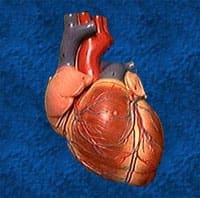| Therapy: Patients With Cardiac Structural Abnormalities or Remodeling Who Have Not Developed HF Symptoms (Stage B) | |||||||||||||||||||||||||||||||||||||||||||||||||||||||||||||||||||||||
 |
|||||||||||||||||||||||||||||||||||||||||||||||||||||||||||||||||||||||
Overview of Stage B |
|||||||||||||||||||||||||||||||||||||||||||||||||||||||||||||||||||||||
| Stage B Structural heart disease but without signs or symptoms of HF e.g., Patients with: - previous MI - LV remodeling including LVH and low EF - asymptomatic valvular disease Goals |
|||||||||||||||||||||||||||||||||||||||||||||||||||||||||||||||||||||||
Summary of therapy options - Stage B |
|||||||||||||||||||||||||||||||||||||||||||||||||||||||||||||||||||||||
Patients without HF symptoms but who have had an MI or have evidence of LV remodeling are at considerable risk of developing HF. In such patients, the incidence of HF can be decreased by reducing the risk of additional injury and by retarding the evolution and progression of LV remodeling. Initial appropriate measures include those listed as Class I recommendations for patients in Stage A (also see Section V). Recommendations
1. All Class I recommendations for Stage A should apply to patients with cardiac structural abnormalities who have not developed HF. (Levels of Evidence: A, B, and C as appropriate) 2. Beta-blockers and angiotensin converting enzyme inhibitors should be used in all patients with a recent or remote history of MI regardless of EF or presence of HF (See drug tables at bottom). (Level of Evidence: A) 3. Beta-blockers are indicated in all patients without a history of MI who have a reduced LVEF with no HF symptoms (See drug tables at bottom). (Level of Evidence: C) 4. Angiotensin converting enzyme inhibitors should be used in patients with a reduced EF and no symptoms of HF, even if they have not experienced MI. (Level of Evidence: A) 5. An angiotensin II receptor blocker should be administered to post-MI patients without HF who are intolerant of angiotensin converting enzyme inhibitors and have a low LVEF. (Level of Evidence: B) 6. Patients who have not developed HF symptoms should be treated according to contemporary guidelines after an acute MI. (Level of Evidence: C) 7. Coronary revascularization should be recommended in appropriate patients without symptoms of HF in accordance with contemporary guidelines (see ACC/AHA Guidelines for the Management of Patients With Chronic Stable Angina). (Level of Evidence: A) 8. Valve replacement or repair should be recommended for patients with hemodynamically significant valvular stenosis or regurgitation and no symptoms of HF in accordance with contemporary guidelines. (Level of Evidence: B)
1. Angiotensin converting enzyme inhibitors or angiotensin II receptor blockers can be beneficial in patients with hypertension and LV hypertrophy and no symptoms of HF. (Level of Evidence B) 2. Angiotensin II receptor blockers can be beneficial in patients with low EF and no symptoms of HF who are intolerant of angiotensin converting enzyme inhibitors. (Level of Evidence: C) 3. Placement of an ICD is reasonable in patients with ischemic cardiomyopathy who are at least 40 days post-MI, have an LVEF of 30% or less, are NYHA functional class I on chronic optimal medical therapy, and have reasonable expectation of survival with a good functional status for more than 1 year. (Level of Evidence: B)
1. Placement of an implantable cardioverterdefibrillator might be considered in patients without HF who have nonischemic cardiomyopathy and an LVEF less than or equal to 30% who are in New York Heart Association functional class I with chronic optimal medical therapy and who have a reasonable expectation of survival with good functional status for more than one year. (Level of Evidence: C)
1. Digoxin should not be used in patients with low EF, sinus rhythm, and no history of HF symptoms, because in this population, the risk of harm is not balanced by any known benefit. (Level of Evidence: C) 2. Use of nutritional supplements to treat structural heart disease or to prevent the development of symptoms of HF is not recommended. (Level of Evidence: C) 3. Calcium channel blockers with negative inotropic effects may be harmful in asymptomatic patients with low LVEF and no symptoms of HF after MI (see full-text guideline in Stage C). (Level of Evidence: C)
|
|||||||||||||||||||||||||||||||||||||||||||||||||||||||||||||||||||||||
Reference |
|||||||||||||||||||||||||||||||||||||||||||||||||||||||||||||||||||||||
| Direct quotes from this valuable reference: Hunt SA, Abraham WT, Chin MH, Feldman AM, et al. ACC/AHA 2005 Guideline Update for the Diagnosis and Management of Chronic Heart Failure in the Adult: a report of the American College of Cardiology/American Heart Association Task Force on Practice Guidelines (Writing Committee to Update the 2001 Guidelines for the Evaluation and Management of Heart Failure): developed in collaboration with the American College of Chest Physicians and the International Society for Heart and Lung Transplantation: endorsed by the Heart Rhythm Society. Circulation. 2005 Sep 20;112(12):e154-235. Epub 2005. Link: http://circ.ahajournals.org/cgi/content/full/112/12/e154 |
|||||||||||||||||||||||||||||||||||||||||||||||||||||||||||||||||||||||
Therapy: Patients With Cardiac Structural Abnormalities or Remodeling
Reference(s)
National Institutes of Health, U.S. National Library of Medicine, DailyMed Database.
Provides access to the latest drug monographs submitted to the Food and Drug Administration (FDA). Please review the latest applicable package insert for additional information and possible updates. A local search option of this data can be found here.

